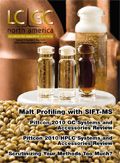The FDA's Teeth Get Sharper
LCGC North America
Many readers who also subscribe to LCGC's sister publication, Spectroscopy, may have read industry expert Bob McDowall's November 2009 column on the new posture of the U.S. FDA ("The Tiger Has Sharp New Teeth," Spectroscopy 24[11], 23–29 [2009]). As he saw it, "The new FDA Commissioner wants a strong FDA and is backing her words with action."
Many readers who also subscribe to LCGC's sister publication, Spectroscopy, may have read industry expert Bob McDowall's November 2009 column on the new posture of the U.S. FDA ("The Tiger Has Sharp New Teeth," Spectroscopy24[11], 23–29 [2009]). As he saw it, "The new FDA Commissioner wants a strong FDA and is backing her words with action." In light of the news coming out of Washington at the time of this writing, he may have been more correct than he imagined. Here we are just a few months later, and the internet, cable news networks, and radio talk shows are all abuzz with the latest initiative put in place by the FDA and its commissioner, Dr. Margaret Hamburg, to limit the amount of sodium Americans consume.

David Walsh
According to the Washington Post (4/20/10), "The effort would eventually lead to the first legal limits on the amount of salt allowed in processed foods," and would also lead to an unprecedented show of power on the part of not only the FDA, but the federal government in general. And while the left may cheer such a move as protecting public health and libertarians and the right may express shock at such a chilling invasion of personal freedoms, one is left to wonder what the implications of such a posture on the part of the FDA may be for the separations community in particular and laboratories in general.
At the very least, it seems to indicate that regulations such as the postinspection response program described by McDowall (initiated on September 15, 2009) will be the norm rather than the exception. And new requirements such as complete responses to 483 observations within 15 working days could be a harbinger of further regulations to come for laboratories in the U.S., rather than a one-time move.
It will be interesting to see how this initiative plays out in the realm of public opinion, where the FDA will either be emboldened to pass further regulations and restrictions (sharpening the tiger's teeth further) or chastened by public outcry. One thing is certain, we will all be hearing more on this in the weeks and months to come.
David Walsh
Editor-in-Chief

Investigating 3D-Printable Stationary Phases in Liquid Chromatography
May 7th 20253D printing technology has potential in chromatography, but a major challenge is developing materials with both high porosity and robust mechanical properties. Recently, scientists compared the separation performances of eight different 3D printable stationary phases.
Detecting Hyper-Fast Chromatographic Peaks Using Ion Mobility Spectrometry
May 6th 2025Ion mobility spectrometers can detect trace compounds quickly, though they can face various issues with detecting certain peaks. University of Hannover scientists created a new system for resolving hyper-fast gas chromatography (GC) peaks.
University of Oklahoma and UC Davis Researchers Probe Lipidomic Profiles with RP-LC–HRMS/MS
May 6th 2025A joint study between the University of Oklahoma Health Sciences Center (Oklahoma City, Oklahoma) and the UC Davis West Coast Metabolomics Center (Davis, California) identified differentially regulated lipids in type 2 diabetes (T2D) and obesity through the application of reversed-phase liquid chromatography-accurate mass tandem mass spectrometry (RP-LC-accurate MS/MS).

.png&w=3840&q=75)

.png&w=3840&q=75)



.png&w=3840&q=75)



.png&w=3840&q=75)









